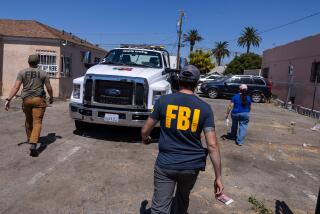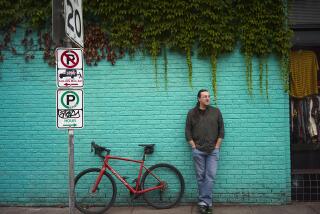Crimes of Fashion
As heists go, this was a piece of surgery.
Four robbers came armed with .357 Magnums, a pair of walkie-talkies, two vehicles and a simple plan: A two-man operations team would enter the store as the last customer left, minutes before closing. They would obtain details of the alarm system, order the store owner and his clerk to stick their noses into the carpet, duct-tape their wrists, then radio an all-clear to the command team outside.
It went like quartz clockwork.
The gang filled four fabric laundry sacks in 15 minutes and the haul was about $50,000.
Mostly in cigars.
âThey certainly knew cigars,â says Karl Koplin Jr., victim and operator of the Cigar Co. on polite Ventura Boulevard in Woodland Hills, where streets see more joggers than crime. âThey took Davidoffs, Paul Garmirians, Avos and Partigas. And cigars in unopened boxes, because they would be fresher and keep longer.â
Koplin has no admiration for the those who balanced his life on their trigger fingers, but concedes these âwere not people chewing bubble gum on the street.â
Nor did they leave LAPD detectives much to chew on.
Except the realization that this was one more crime of fashion; another 15 minutes of infamy engineered by boosters who are monitoring consumer trends and mining national fads faster than Ralph Lauren.
Personal computers, laptops, chips and mother boards are being lifted faster than police computers can keep track of their disappearances. The FBI recently recovered 15 stolen Harley-Davidson motorcycles quite unable to hide on the minuscule Caribbean island of Aruba. Prized here, priceless there--and in Eastern Europe, hot Harleys sell for twice what they cost new.
A craze for country-Western music in Japan recently caused an epidemic of designer-jean hijackings in New York. Syndicates specializing in the theft of collector cars--with Chevrolets of the â50s and Austin-Healeys of the â60s high on their hit parade--are exporting the classics to eager Middle East collectors and investors.
As soar sport-utility sales in the United States, so rise overseas passions for the chunky four-wheelers, with South America a popular destination for Land Rovers and Mitsubishi Monteros. And in auto theft, it seems, no owner is safe and no sport-utility sacred.
So when the FBIâs Los Angeles office decided to purchase a Jeep Grand Cherokee for official business, it made sure the vehicle was fitted with a LoJack theft tracking device.
Ergo, says Det. Sgt. Jeff Ross, a theft-ring specialist with the Norridge, Ill., police department, just about any item that becomes hot will probably become hot merchandise.
âLadiesâ designer suits and leather coats that are big here are going to Russia where they are just as popular,â he says. âAs the cigar thing starts to take hold [in Southern California], we probably wonât be far behind. Iâm just surprised we havenât seen something in Beanie Babies.â
Sorry, sarge. Police in Carol Stream, Ill., recently arrested a man for kidnapping Bubbles, Digger, Garcia, Radar and 1,200 other Beanie Babies--with an estimated street value of $10,000--from a manufacturerâs warehouse.
Leaving Jean OâNeil of the National Crime Prevention Council to conclude: âProfessional thieves are people with a lot of experience in figuring what consumers want, while there will always be people who want something for less.â
But what motorcycle thieves are getting more of these days is Det. Peter Simet of the Milwaukee Police Department, who is something of a global specialist in motorcycle heists.
He owns Harley-Davidsons and understands how, like Elvis and Chicken McNuggets, such Americana is captivating a world. Harley-Davidsonâs factory, temple of the nationâs chopper and hog heaven, is on his Milwaukee turf. So each bike lost, Simet says, is something he takes personally.
âThere are no joy riders taking Harleys,â he declares, âjust professional rings stealing about 2,500 bikes a year and shipping them to Sweden, Poland, Latvia and other countries where, if it ainât stolen there, they donât really care where it came from.â
Lt. John Alba remembers his early years with the Los Angeles Police Department and a rage of the late â70s when pet stores were being ripped off because exotic birds and monkeys were in demand. Conversely, report other officers, when a fad fades so does its dark side.
Rolex robberies, Alba reports, peaked when wearers learned not to wave their wrists out car windows. Or gave up wearing their gold Presidents during the week, or at night.
âAnd when animal rights activists came along, fur robberies went into the toilet,â says a New York Police Department representative.
Despite Chardonnays and Chateuneufs being the smart thing, there is no evidence of black marketing of fine wines. For one thing, explain the experts, there is no world shortage of good inexpensive wines. For another, the average bad guy wouldnât know a Romanee-Conti from Ripple.
âA stolen wine would also have to be removed from its temperature-controlled environment,â notes Ron Breitstein, a partner in the Duke of Bourbon at Canoga Park. âIt would spoil in a day if you put it into the trunk of your car on a 110-degree day.â
*
Still, the illegal supply of any voracious demand is a horse-and-carriage thing well rooted in world history.
Capone ran booze to a thirsty America. Drake plundered Spanish treasure ships because Queen Elizabeth needed to fund a navy. Robin Hood robbed the rich to feed the poor, and Burke and Hare snatched bodies for resale to gross anatomy classes. Even Frank and Jesse James sent money home.
And greed coupling need remains the backbone of todayâs tailgate retailing--a $76-billion growth industry that experts say certainly would decline if the Evanses werenât always trying to keep up with the Joneses.
Such as the snooty appeal of being joined at the ear to a cell phone. U.S carriers lost $650 million in 1995 to high-tech thieves who not only reached out and touched somebody elseâs phone, but electronically harvested numbers and cloned the mobiles for free long-distance service.
âThe good news is that the bottom is falling out of the stolen cell phone market, with street value of phones dropping from $25 to $5,â reports Tim Ayers of the Cellular Telecommunications Industry Assn. in Washington, D.C. He credits the recovery to energetic prosecution of cloners, and to security countermeasures that authenticate legitimate calls and make it tougher to tap into big city cell phone service. âThe bad news is, authentication is pushing cloning out to rural, outlying markets.â
The worst news, Ayers adds, is that bad guys continue to position themselves a heartbeat behind the technology.
âWe are quite concerned about the next assault,â he says. âIt probably will be on the system itself, [electronically] breaking into the files of carriers to obtain authentication codes.â
Despite the chessboard precision of computer sciences, nobody has computed the national cost of hard- and software thievery. But experts peg rough estimates at $8 billion a year and their loss predictions at $200 billion by millenniumâs end.
With computer purchases Pentium-paced and nations upgrading by the hour, itâs certainly a fashionable crime that pays. Hardware is virtually impossible to trace, because not all computers carry serial numbers. Microchips tiny enough for priority overnight mail between the coasts are considered gold coinage.
Earlier this year, a team broke into Cyber Solutions Inc. in Lancaster, Pa., ignored a large-screen TV and camera equipment, and left with $50,000 in computer equipment.
The haul--more than triple the take from the average bank robbery--included 11 central processing units.
âOn those, we had all our information,â says Judeann Stips, director of sales for the training and consulting firm. âIt was backed up on a file server. They took that. Our file server was automatically backed up on an optical scanner. And they took that.â
*
Of the 1.5 million vehicles stolen in the United States each year, about 20% surface whole and overseas with identification numbers filed off.
Middle East buyers prefer Cadillacs, Lincolns and BMWs. Oldsmobiles are big in Eastern Europe; so are Mercedes-Benzes and Jaguars. Porsches and Lexuses are hot in Australia and along the Pacific Rim; South Africa has started to appear on law enforcersâ radar as another outlet for sport-utility vehicles.
Raleigh Floyd is with the National Insurance Crime Bureau and sees overseas buying of a stolen car easier than visiting Peoria Saturn. Say some Colombian stud wants to look cool at the wheel of a black Toyota 4 Runner with chrome wheels, spotlights and a CD player.
âThrough channels, someone will end up in a Los Angeles parking lot shopping for just that car, finding it, stealing it and driving it to the nearest port,â Floyd says. âUsually in a matter of days.â
And the larceny doesnât end there.
For, says Joe Abely, president of the Boston-based LoJack Co., silent bird dog of vehicles in 15 nations, it is not smart to drive a stolen red Porsche 911 across town. Or park it for a couple of days near the docks.
âSo rings are stealing tractor trailers to haul off the cars,â he says. âOr stealing empty containers for those cigars. Trust me, whatever is expensive and popular is going to get stolen.â
That includes expensive clothing, currently anything by Eddie Bauer or Anne Klein, Bally or Burberry, Guess or Gap.
Each year, more than $1 billion in desirable brand merchandise leaves stores in the false linings, deep pockets and booster bags of career shoplifters.
Interstate rings--some staffed by nomadic thieves recruited from the underworlds of such diverse locales as Greece and Chile--ship loot to distribution centers in New York and Los Angeles. Then overseas to South America, Europe and the Middle East.
Det. Joe Morrash, of the Alexandria, Va., Police Department is a 20-year expert on such organizations and their operations.
Morrash has known rings to lift $5,000 worth of merchandise in an hour; also a six-person Chilean team that stole $150,000 in designer suits and separates from three Virginia malls.
And Morrash knows his apartment boutiques.
âWe hit one in New York City that from the outside looked like a slum,â he says. âInside, it looked like Macyâs with $2 million in stolen clothes.â
The place also contained clear evidence of dishonor among thieves.
Signs were posted warning against shoplifting.
âThey even checked your bags on the way out,â says Morrash.


